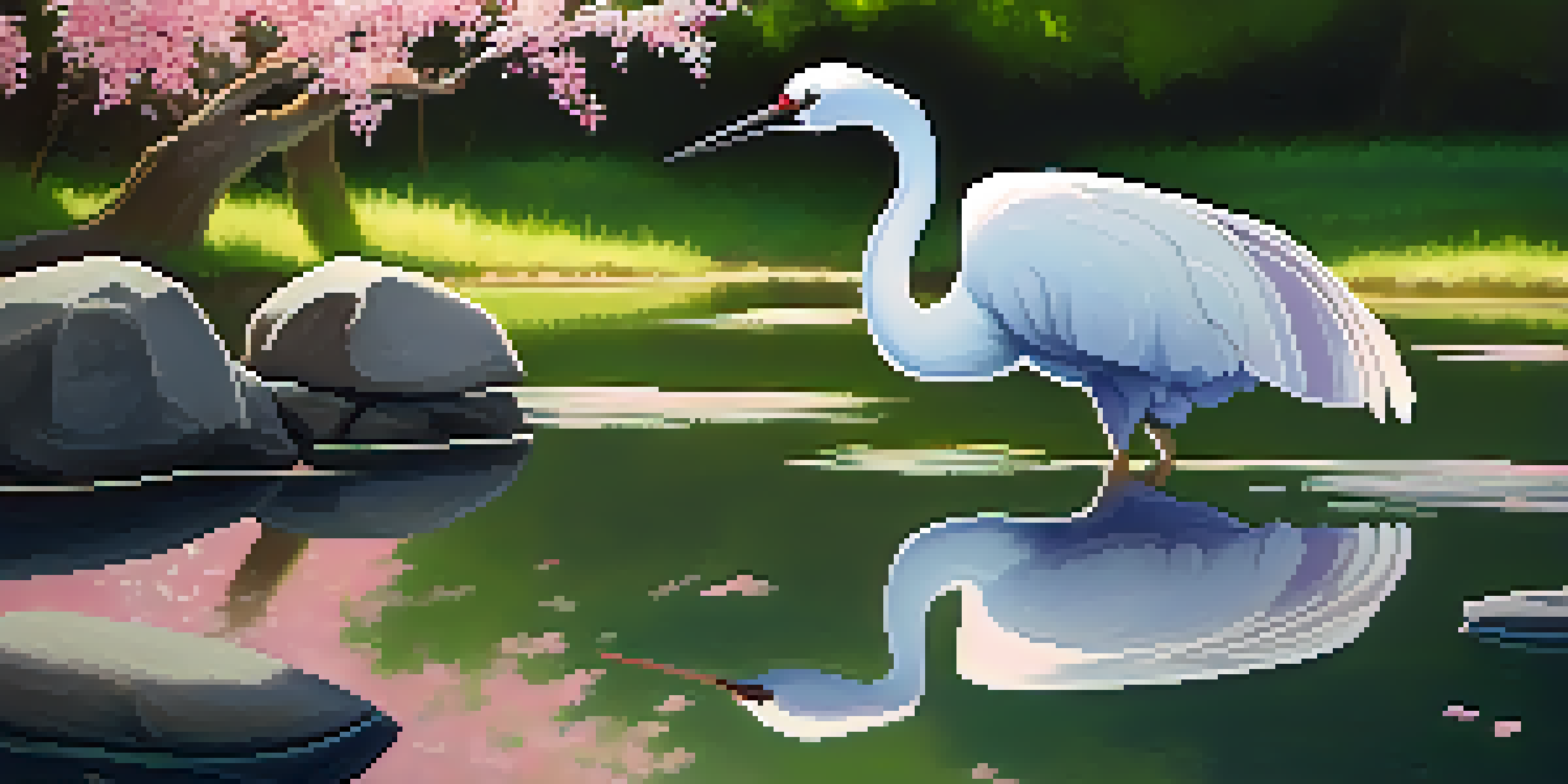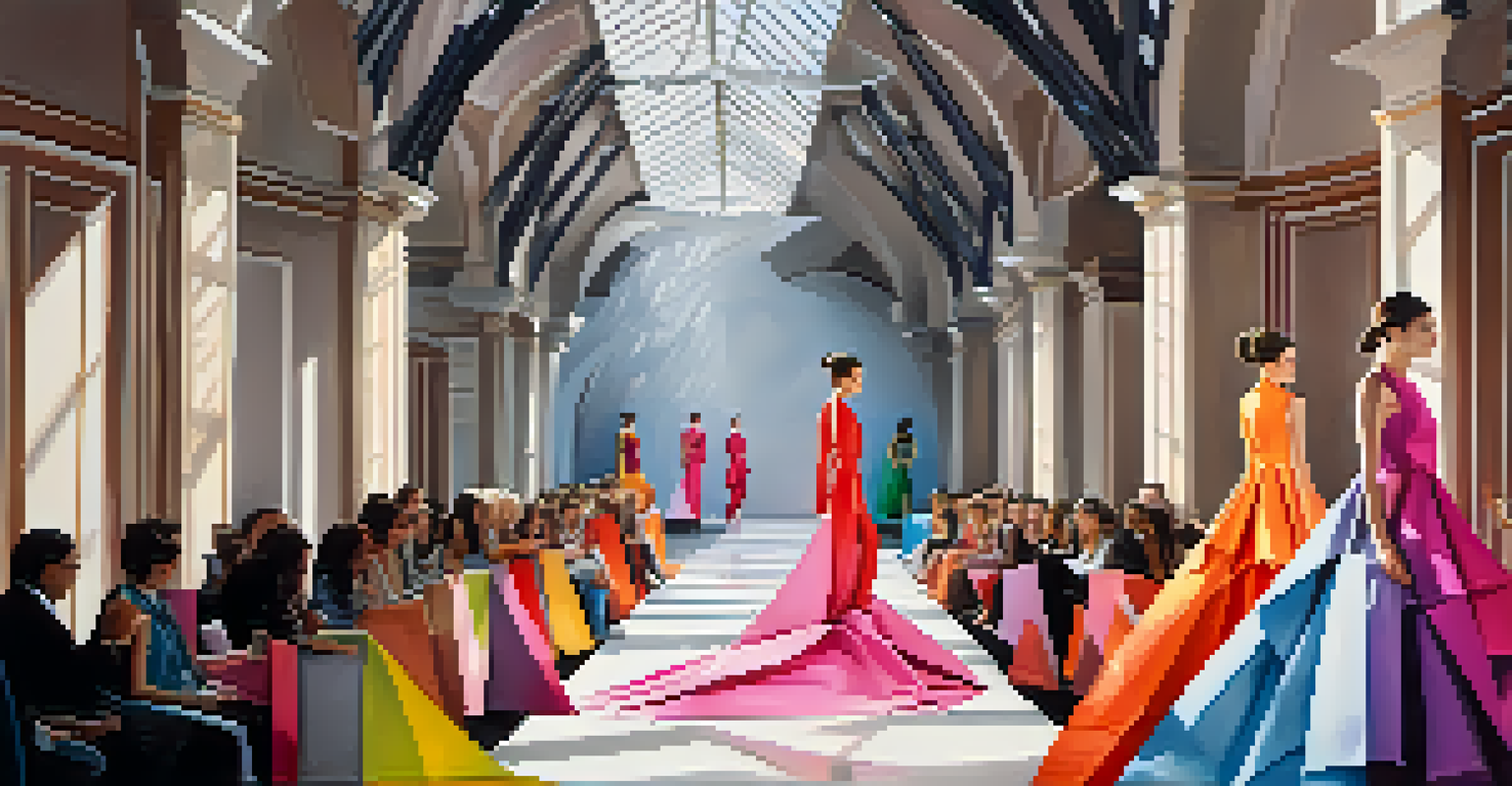Origami in Pop Culture: Its Influence in Film and Art

The Art of Paper Folding: A Brief History of Origami
Origami, the traditional Japanese art of paper folding, dates back to the 17th century. This intricate practice transforms simple sheets of paper into stunning sculptures, showcasing creativity and skill. Over the years, origami has evolved, influencing various cultures and art forms, making it a captivating subject in both history and modern art.
Origami is the art of paper folding, but it is also a metaphor for life—how we fold our experiences shapes who we are.
The basic principles of origami begin with folding techniques that can create complex designs, from simple cranes to elaborate models. This versatility allows artists to express their ideas, emotions, and even mathematical concepts through paper. As a result, origami has found its way into education, therapy, and even engineering, demonstrating its multifaceted nature.
In the context of pop culture, origami serves as a bridge between tradition and contemporary expression. Its appeal lies not only in its aesthetic quality but also in the storytelling potential it offers. As we explore its influence in film and art, we see how this ancient craft continues to inspire and captivate audiences worldwide.
Origami in Film: A Symbol of Transformation
In the realm of cinema, origami often symbolizes transformation and change. Films like 'Inception' and 'Blade Runner 2049' use origami as a narrative device, enhancing themes of identity and perception. The act of folding paper mirrors the complexity of the characters' journeys, making it a powerful visual metaphor.

For instance, in 'Inception', origami figures represent the subconscious and the layers of dreams. The careful folding of paper parallels the meticulous planning required to navigate the film's intricate plot. This thoughtful inclusion elevates the storytelling, inviting viewers to ponder deeper meanings behind the art.
Origami: Art Meets Education
Origami serves as a hands-on tool for teaching various subjects, enhancing creativity and critical thinking in students.
Moreover, animating origami in films brings an additional layer of creativity. Movies like 'Kubo and the Two Strings' integrate origami-inspired animation, blending traditional techniques with modern technology. This fusion not only highlights the beauty of origami but also showcases its potential to tell compelling stories.
Art Installations: The Visual Impact of Origami
Origami has made significant strides in the contemporary art scene, with various artists incorporating it into their installations. These large-scale works often challenge viewers' perceptions of space and form, creating immersive experiences. The delicate nature of paper contrasts with the enormity of the installations, captivating audiences with their intricacy and scale.
In every piece of paper, there is a story waiting to unfold, much like the complexities of our own lives.
Artists like Jennifer Maestre and Chris Palmer have redefined origami by using unconventional materials and techniques. Their works often explore themes of nature and the environment, prompting dialogue about sustainability and the fragility of life. Through these installations, origami transcends its traditional boundaries, becoming a medium for social commentary.
Additionally, origami's mathematical precision appeals to artists interested in geometry and symmetry. Some installations utilize complex folding techniques to create visually stunning patterns, engaging viewers on multiple levels. This intersection of art and mathematics underscores origami's versatility and its importance in contemporary artistic expression.
The Influence of Origami in Graphic Design
In graphic design, origami-inspired aesthetics have gained popularity, creating a unique visual language. Designers often use folding techniques to create logos, packaging, and advertisements that stand out. This approach not only captures attention but also conveys a sense of craftsmanship and creativity.
For example, the use of origami in branding can evoke feelings of innovation and playfulness. Companies like Foldable.me leverage this concept, allowing users to create their own paper avatars. Such interactive experiences engage audiences, fostering a deeper connection with the brand.
Origami's Impact on Fashion Design
The structural beauty of origami inspires innovative fashion designs, allowing for unique silhouettes and sustainable practices.
Furthermore, the principles of origami influence layout and composition in digital design. By incorporating folds and layers, designers can create dynamic visuals that guide viewers' eyes through the content. This integration of origami enhances the overall user experience, making it a valuable tool in modern graphic design.
Origami and Education: A Tool for Learning
Origami has found a significant place in educational settings, serving as a tool for teaching various subjects. Its hands-on approach encourages creativity, critical thinking, and problem-solving skills. Teachers often use origami to illustrate mathematical concepts such as geometry, fractions, and spatial relationships.
For instance, folding a paper crane can help students understand angles and symmetry, making abstract concepts tangible. This interactive method not only engages students but also fosters a deeper understanding of the material. As a result, origami becomes a bridge between art and education, enhancing the learning experience.
Moreover, origami can also be used in therapeutic settings, aiding in fine motor skill development and mindfulness. By focusing on the process of folding, individuals can experience a sense of calm and accomplishment. This therapeutic aspect underscores the holistic benefits of origami, extending its influence beyond traditional educational frameworks.
The Role of Origami in Fashion Design
Origami's influence extends into the world of fashion, where designers embrace its structural beauty to create innovative garments. The art of folding allows for unique silhouettes and intricate details, transforming fabric into wearable art. This trend has led to a resurgence of interest in sustainable fashion, as origami techniques often require less material.
Designers like Issey Miyake have become synonymous with origami-inspired fashion, showcasing how folds can create movement and texture in clothing. This playful approach to design attracts attention and invites wearers to engage with their attire on a deeper level. Each fold tells a story, making the garment an extension of the wearer's personality.
Origami's Role in Pop Culture
Origami continues to influence film, art, and design, showcasing its timeless appeal and adaptability in modern contexts.
Furthermore, the incorporation of origami in fashion encourages a dialogue about the intersection of art and functionality. As designers experiment with materials and techniques, they challenge conventional notions of what clothing can be. This innovative spirit reflects the essence of origami, inspiring creativity and pushing boundaries in the fashion industry.
The Future of Origami in Pop Culture
As we look to the future, origami's presence in pop culture is likely to expand even further. With advancements in technology, we may see innovative applications of origami in fields like robotics and architecture. For example, origami-inspired designs are being explored in developing compact and efficient structures, showcasing its potential in practical applications.
Moreover, the digital age allows for a broader reach of origami art through social media platforms. Artists and enthusiasts can share their creations and tutorials, fostering a global community around this ancient craft. This connectivity enhances collaboration and inspires new generations to explore the possibilities of origami.

Ultimately, origami's influence in film, art, and design underscores its timeless appeal and versatility. As it continues to evolve, origami will remain a source of inspiration and creativity, bridging the gap between tradition and modernity. Its ability to convey complex themes and emotions ensures its place in the cultural narrative for years to come.